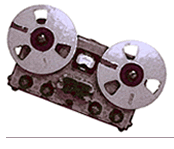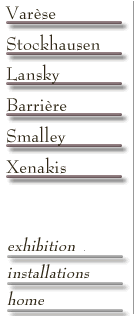


Live Program Notes Presented at the ConcertThe incredible colors, textures, and rhythmic complexity of Stockhausen's music are of a distinctly 20th-century vintage. Indeed, the taped sounds and electronically generated sounds of Gesang der Jünglinge were not technologically possible until after World War II. Unlike many of his peers, Stockhausen wanted not merely to collage together found sounds, but to analyze them into such constituent elements as their attack, decay, frequency, amplitude, and distribution of overtones, in order to construct entirely new sounds. Stockhausen's approach to sounds is analogous to uncovering the DNA of a living organism, and then inventing new gene sequences and new forms of life. Just as DNA is invisible to the naked eye, and yet governs the observable structure and behavior of a living organism, in Gesang der Jünglinge, a complex but inaudible mathematical series governs the music's audible form and activity. Although Stockhausen's methods are radical, they exhibit classical music's centuries-long quest for order and organic unity. Thus Gesang's recurring phrase, "Preiset den Herrn," meaning "Praise the Lord," can be thought of as a descendant of one of Bach's chromatic fugue melodies, which, in augmentations, diminutions, and inversions, binds together a fugue. The phrase "Preiset den Herrn," fragmented, transposed, sped up, slowed down, and altered in timbre, similarly underlies Gesang der Jünglinge. On the screen is a sketch (image 1, at right) by Stockhausen of what we might call Gesang's "refrain." The unconventional musical notation is read like a Cartesian graph, with the vertical axis representing pitch and the horizontal axis, the passage of time. In this sketch, the phrase "Preiset den Herrn" is repeated twice, with the resulting eight syllables distributed over thirteen distinct pitches. Now I'll play an excerpt in which the clearest version of the refrain appears, early in the piece. It is only five seconds long, so we'll hear the clip twice. Here the phrase is fairly comprehensible, but in Gesang's thirteen minutes, such clarity is the exception. In his treatment of Gesang's text, the composer quite deliberately skirts the limits of hearing and of language in order to explore how people make sense out of sounds. Words and sounds will seem alternately familiar and strange, and, as the composer intended, they are often indistinguishable from each other. Indeed, sounds that lie somewhere in between the human and the mechanical are among Gesang's most mysterious and affecting timbres. Since Gesang der Jünglinge's premiere in 1956, nearly half a century ago, Stockhausen's electronic and spatial innovations have spread out in all directions. The composer's appearance on the cover of a Beatles' album (image 2) is just one example of the many tributes to his enduring influence. Now let's listen to Gesang der Jünglinge. |